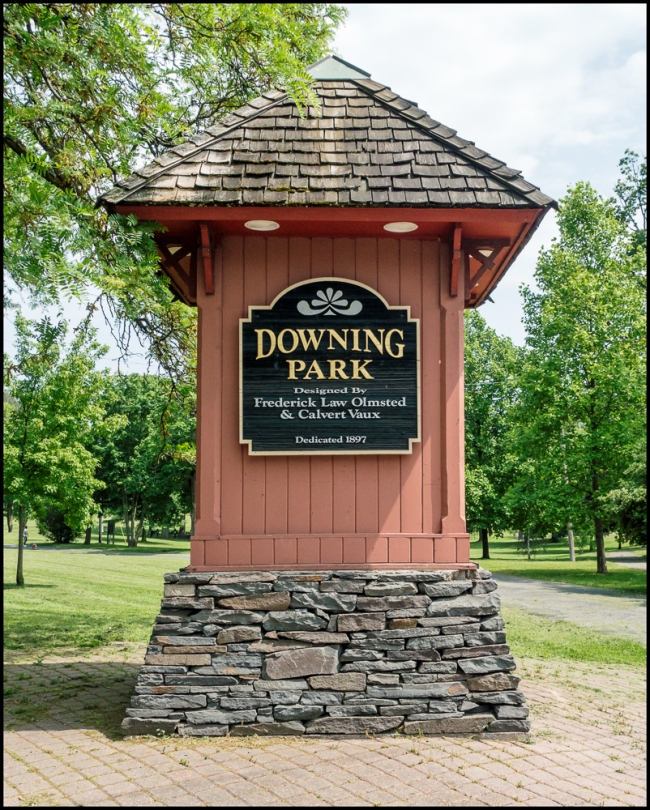I’ve often passed Downing Park in Newburgh, but this was the first time I’d visited it (while taking the dog for a walk).
It has an interesting history. According to the City of Newburgh website:
Most of Downing Park was a farm owned by the Smith family, whose 1750s farmhouse stood at the present location of the pergola.
The idea to build a park was conceived by Mayor O’Dell in the late 1880s. Citing the population growth and increases in property values, he acquired the 25-acre Smith estate, later adding ten more acres.
The City offered the commission to design the park to Calvert Vaux and Frederick Law Olmsted, the designers of New York City’s Central Park. The landscape designers agreed in 1889, stipulating that it be named after their mentor (and Vaux’s former partner) Alexander Jackson Downing.
Actual construction began in 1894, and the park was opened to the public in 1897.
In addition to the farmhouse, the park originally featured an observatory and a bandshell. The observatory, designed by Calvert’s son Downing Vaux, rested on the highest point in the park, commanding spectacular Hudson River views. The structure was torn down in 1961 as part of an “urban renewal” project.
Little is known about the original bandshell, and no clear pictures exist. Described as being built in Downing’s ‘rustic style,’ it was removed in the late 1920s.
At the turn of century, the farmhouse was turned into a smallpox sanatorium. In 1908 the flu epidemic ended; the city condemned the house, and it was burned to the ground. Later that year, architect Frank Estabrook designed the pergola to be built on the farmhouse foundations.
The Shelter House, designed in 1934 by Gordon Marvel, provided shelter in the winter for those ice skating on the Polly Pond.
The outdoor amphitheatre was built in 1946. Used for weekly band concerts for many years, the amphitheatre originally had a moat filled with goldfish at the front of the stage
.
According to Heritage Newburgh:
Though many who pass by the beautiful park do not realize its illustrious history, in fact it was designed by two of America’s foremost 19th-century landscape architects, themselves superseded in prominence only by the park’s namesake, Andrew Jackson Downing.
Frederick Law Olmstead and Calvert Vaux were commissioned by the City of Newburgh in 1889 to design the park in honor of their late mentor Andrew Jackson Downing.
Downing born and raised in Newburgh had achieved great fame as one of the most distinctive style-makers of America’s 19th century influencing both landscape design and residential architecture, some of which can still be seen in Newburgh’s East End Historic District.
However, Downing and 79 others perished horribly in 1852 in a fire on the ill-fated steamboat, the Henry Clay, which was racing from Kingston to New York. Boats in those days eclipsed by railroad travel, frequently raced for bragging rights, despite the danger it posed to the steam engine boiler rooms aboard the wooden ships.
Downing was not quite 37, but had left an incredible mark and a huge void.
Downing revolutionized designs for urban green spaces, advocating for large and beautifully conceptualized public spaces, aristocratic in scope but intended also for the masses. He was the genius behind the idea for New York City’s Central Park.
In his absence, Downing’s protégés Olmstead and Vaux were commissioned to actually create Central Park, and they did, engineering a public masterpiece.
It’s not a stretch to consider Downing Park and see similarities to Central Park. And why not? The landscape architects employed the design vernacular that had made Downing famous:
design serpentine walkways
unexpected vistas
peaceful rolling hills
a central water feature
native specimen trees.These are all the hallmarks of Downing’s inspired approach to landscape architecture which his two students executed effortlessly.
An article in the New York History Blog is also worth reading: “Newburgh’s Downing Park, A Short History”
Taken with a Sony RX-100 M3.

